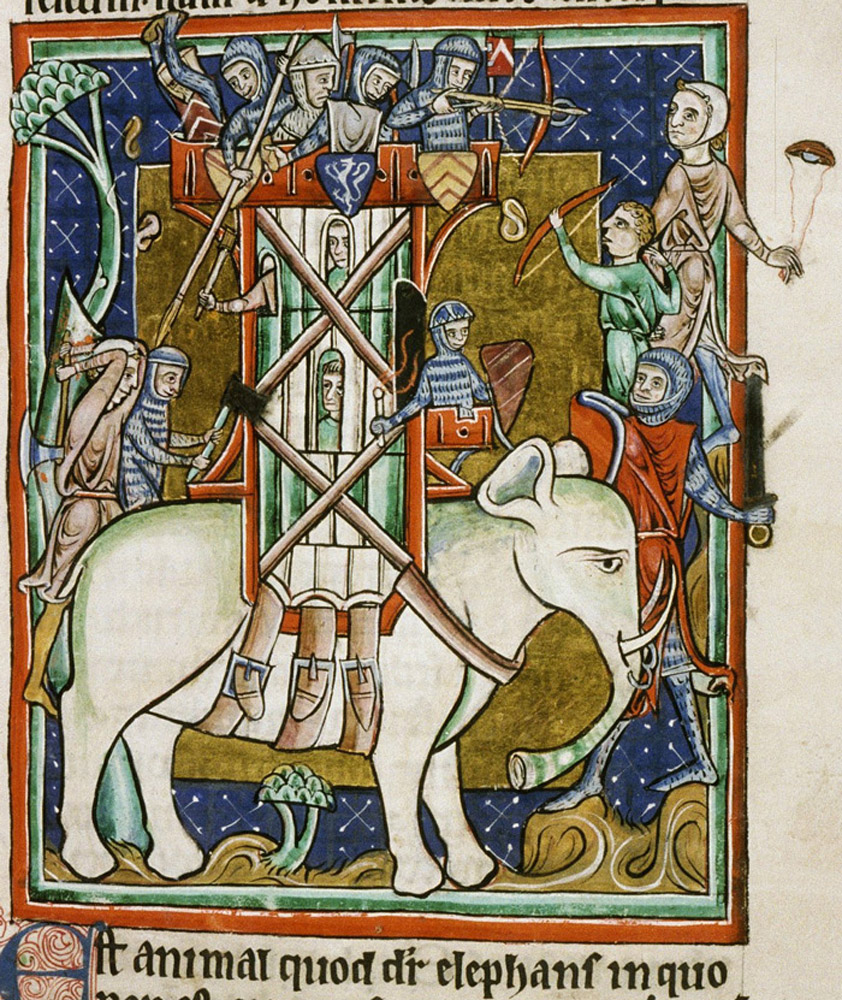
The bear forms its offspring with its mouth. The female gives birth to a small eyeless piece of flesh which is gradually shaped in to a cub by licking. It is born head first resulting in a weak head supported by strong loins which allow the animal to stand on its hind legs.

The leucrota is a swift animal born in India. It is the size of an ass with the hindquarters of a stag, the chest and legs of a lion, [a horse’s head and a mouth split open as far as its ears. It has a continuous jawbone instead of teeth].
Text Translation:
Of the bear The bear is said to get its name because the female shapes her new-born cub with her mouth, ore, giving it, so to speak, its beginning, orsus. For it is said that they produce a shapeless fetus and that a piece of flesh is born. The mother forms the parts of the body by licking it. The shapelessness of the cub is the result of its premature birth. It is born only thirty days after conception, and as a result of this rapid fertility it is born unformed. The bear’s head is not strong; its greatest strength lies in its arms and loins; for this reason bears sometimes stand upright. Bears do not neglect the business of healing themselves. If they are afflicted by a mortal blow and injured by wounds, they know how to heal themselves. They expose their sores to the herb called mullein – flomus, the Greeks call it – and are healed by its touch alone. When sick, the bear eats ants. The bears of Numidia stand out from other bears by virtue of the shagginess of their hair.
Bears are bred in the same way, wherever they come from. They do not mate like other quadrupeds but embrace each other when they copulate, just like the couplings of humans. Winter arouses their desire. The males respect the pregant females, and honour them by leaving them alone; although they may share the same lair at the time of birth, they lie separated by a trench. Among bears the time of gestation is accelerated. Indeed, the thirtieth day sees the womb free of the cub. As a result of this rapid fertility, the cubs are created without form. The females produce tiny lumps of flesh, white in colour, with no eyes. These they shape gradually, holding them meanwhile to their breasts so that the cubs are warmed by the constant embrace and draw out the spirit of life. During this time bears eat no food at all in the first fortnight; the males fall so deeply asleep that they cannot be aroused even if they are wounded, and the females, after they have given birth, hide for three months. Soon after, when they emerge into the open, they are so unused to the light that you would think they had been blinded. They attack beehives and try hard to get honeycombs. There is nothing they seize more eagerly than honey. If they eat the fruit of the mandrake they die. But they prevent the misfortune from turning into disaster and eat ants to regain their health. If they attack bulls, they know the parts to threaten the most, and will not go for any part except the horns or nose: the nose, because the the pain is sharper in the more tender place.
Of the leucrota The beast called leucrota comes from India. It is the swiftest of all wild animals. It is as big as an ass, with the hindquarters of a deer, the chest and legs of a lion, the head…[Of the parander] … thick coat. It is said that the parander changes its appearance when it is afraid and, when it hides itself, takes on the likeness of whatever is near – a white stone or a green bush or whatever other shape it prefers.
This part of the manuscript is a bit confusing. The leucrota is somewhat confusingly described as having the rear parts of a stag, and the chest and legs of a lion, but with cloven hooves. Its most distinctive characteristic is its charming wide-mouthed grin, which stretches across its head. Its teeth are single, continuous pieces of bone, and it is capable of imitating the sound of a human voice.
The Parandrus is a beast from Ethiopia that can change its appearance, so that it can conceal itself by taking on the appearance of its surroundings. It is colored like a bear, but is the size of an ox and has long hair. It has the head of a stag with branching horns, and has cloven hoofs.



































